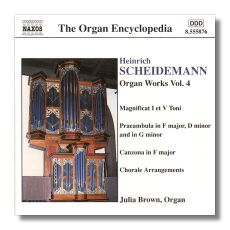
The Internet's Premier Classical Music Source
Related Links
- Latest Reviews
- More Reviews
-
By Composer
-
Collections
DVD & Blu-ray
Books
Concert Reviews
Articles/Interviews
Software
Audio
Search Amazon
Recommended Links
Site News
 CD Review
CD Review
Heinrich Scheidemann

Works for Organ, Volume 4
- Magnificat I Toni
- Benedicam Domino
- Jesus Christus, under Heiland (III)
- Praeambulum in F Major
- Canzona in F Major
- Nun bitten wir den heiligen Geist
- Praeambulum in D minor
- Mensch, willst du leben seliglich
- In dich hab ich gehoffet, Herr (II)
- Praeambulum in G minor
- O Gott, wir danken deiner Güt
- Herr Christ, der einig Gotts Sohn (II)
- De ore prudentis procedit mel
- Magnificat V Toni
Julia Brown, organ
Naxos 8.555876
Here is Volume 4 in the excellent Naxos series by Julia Brown of the splendid organ works of Heinrich Scheidemann (c 1595-1663). Described by contemporary composer Johann Mattheson as having playing '…nimble with the hand, merry and full of humor', Scheidemann was also 'well grounded in the art of composition and his chorale harmonizations were easily playable.' This is not to say that the music here is trite or superficial. Quite the opposite – it's wholly satisfying, memorable and worth investigating; especially if you're new to the repertoire. Indeed if you have any interest in the north German early Baroque organ, get this recording now (and the other remaining Volumes, 3 and 5) while it's still available: Volumes 1 and 2 no longer are.
After a three-year and obviously influential period of study with Sweelinck in Amsterdam between 1611 and 1614, Heinrich Scheidemann became a renowned figure in the north German organ world, not only playing for the rest of his life in the St. Catherine's Church, Hamburg; but also advising on the design and construction of organs in Brunswick, Lübeck, Bremen and elsewhere. His Lutheran predisposition to plain (and non-coercive) worship and supporting music which has a certain humility are evident in all the pieces on this disk. It is self-confident music too, exposed with expert playing by Julia Brown on a North American organ with a rich and appropriately peaceful acoustic.
The repertoire available on Volume 4 is similar to that of the others. There are two Magnifgicats, I and V Toni, a substantial Benedicam Domini (after Lassus) and nearly a dozen chorales and motets plus two of Scheidemann's characteristic Preludes. More melodic than fugal (though the Praeambulum in F Major is a pleasing and highly inventive fugue, showing Scheidemann's capabilities there too), most of the items are nevertheless rich in tone and concept. His use of manuals and pedals is particularly striking; details can be found in the short but apposite accompanying notes. Again Brown has obviously prepared her performance of this – together with the negotiation of some complex meters – with thought and skill. Nor is dance ever very far from the surface in, say, the chorales; that's only partly what gives them their appeal, though. Each item pulls at a different heart string or stimulates a fresh area of the receptive ear; this is not to say that Scheidemann is merely going after 'effects'. His is structured music from a mature soul.
So these are CDs to be snapped up before they too disappear. What may surprise you (particularly if you're new to this repertoire) is just how different one piece is from another, although they're clearly all the work of a very creative composer, whose work deserves to be better known. The music, the playing (see the reviews of Volumes 3 and 5 for assessments of how well Julia Brown approaches Scheidemann) and the consequently gentle yet emotionally mature atmosphere of the whole are simply too good to miss.
Copyright © 2007, Mark Sealey


















